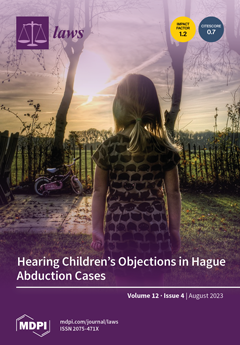Although victims have the right to limited participation in trials and to seek reparations after sentencing, the legal structure of the International Criminal Court (ICC) prioritizes retributive justice over restorative justice and punishment over reparations. Thus, currently, although the perpetrators can be tried
[...] Read more.
Although victims have the right to limited participation in trials and to seek reparations after sentencing, the legal structure of the International Criminal Court (ICC) prioritizes retributive justice over restorative justice and punishment over reparations. Thus, currently, although the perpetrators can be tried through the ICC, it is still difficult to obtain reasonable compensation for the damages suffered by the victims. On the one hand, the ICC’s reparation system may be restricted by the identity of the victim, ICC internal factors, and so on. The current structure of the ICC compensation system allows for hierarchical relationships between victims, while at the same time, there is tension between individual and collective types of compensation. These factors have led to a disconnect and gap between the protection of rights at the theoretical level and actual reparation. This dichotomy between the theoretical protection of the rights of victims and the real protection of victims in practice exists in the ICC. Victims are isolated from the field of vision due to potential repercussions. The idealistic illusion of justice is completed when the ICC stands on the stage and accepts the audience’s praise. However, for compensation in criminal courts, people are paying increasing attention to the legal process and content. In practice, the proportion of victims of international crimes is not low, and in some cases, victims are widespread. It can be seen that criminal compensation for victims is an issue that spans a vast range of people and regions. Nonetheless, there are still research gaps regarding reparation and other ideas of justice according to the ICC, how the ICC provides multifaceted safeguards for victims, and the limitations and influence of the mechanism of the ICC on the compensation of victims. Considering the above problems, this paper aims to analyze the International Criminal Court indemnity cases. This paper wishes to analyze reparations and other ideas of justice under the ICC, examining the approach of the ICC toward compensation for victims, where the ICC is heading regarding reparations for victims, how the reparations system works, and the advantages and disadvantages of the reparations system, as well as what are the potential problems of ICC related to reparations. What guarantees do the ICC’s mechanisms provide for victims to be able to receive reparations? How does the structure of the ICC reparations system conflict with victims’ reparations in practical terms? What are the potential obstacles and gaps between criminal trial reparations and victims? The first chapter wants to analyze the early Nuremberg tribunal, Tokyo tribunal, ICTY, and the ICTR by analyzing whether international criminal justice under these military tribunals was restorative justice or reparation justice and interspersed with analyses of reparation to victims under these tribunals. Then, it analyses it further about justice and reparation of the ICC, and it talks about the compensation for the victim and how the idea of compensation under the ICC has evolved. Using these arguments to analyze reparation and other different ideas of justice under the paly of ICC. The second chapter of the article analyzes the “participatate in trial for compensation”, “The limits of participating in trial”, “Safety protection for victims” to demonstrate the current protection and progress of the ICC system on the issue of victims’ compensation, this is because victims’ participation in the trial will bring a lot of help to the issue of compensation. The article analyses the significance and shortcomings of participation in a trial for compensation, which is necessary and meaningful to the issue of compensation because “participation in trial” and compensation are related and complementary to each other, as participation of the victims will bring a lot of help to the issue of compensation. The article analyses the section “Protection of the financial situation of victims: A possible alternative methods of reparation” because, to some extent, it can be seen as an alternative method of ICC compensation. The third chapter of the article hopes that by analyzing “Little compensation”, “The silence court put on victims’ rights of compensation”, “The ICC’s model of judicial administration remains optional” to argue and analyze how the structure of the ICC reparations system conflict with victim reparations in practical terms. Because the silence the court put on victims’ rights of compensation and the ICC’s model of judicial administration remains optional, both directly impact the issue of compensation. Chapter IV mainly aims to analyze some of the potential negative impacts of the ICC on victim reparations, specifically “The victim’s social death”, “Restrictions on “expression” between the victim and the court”, “Does the ICC hope to improve its attitude to victims?” to specifically analyze and argue these aspects of its potential negative impact on victim reparations. On this basis, this paper analyzes the gap between criminal trial reparations and victims to identify what negatives exist between the two.
Full article





